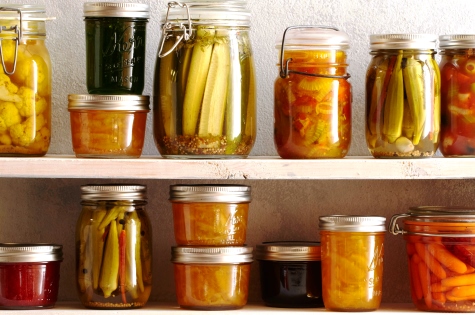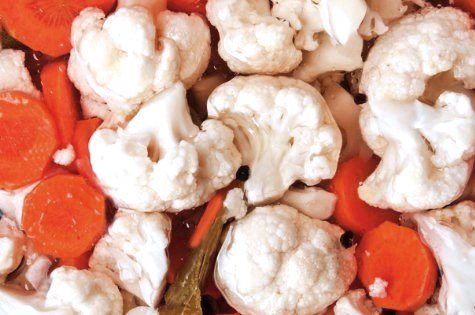It’s not what you think.
I’m not wallowing in wine or whacked out on weed. (At least not right now.) I do, however, have homemade bread baking in the oven, and I’ve just put up a bunch of pickles.
Again, it’s not what you may think. I haven’t joined a commune in Vermont, delved too far into the world of Laura Ingalls Wilder, or taken up extreme right-wing ideologies and moved into a nuclear bunker in Tennessee. I’m just trying to stay hip. And for once, I’ve found I haven’t already aged out of the latest trends.
Both baking and pickling are tres chic here in the UK. That runaway smash tv show The Great British Bakeoff has taken the nation by storm over the last few years.

What was once the province of the WI has now become a national craze. Artisan bakeries are opening across the land, companies are holding their own employee cake contests, and near strangers are getting friendly jabbering about their Genoese sponges.
In the restaurant and television cookery worlds, pickling is equally de rigeur. TV shows like Masterchef: The Professionals are giving us weekly bites of the latest fine dining trends, and along with pistachios, apricots, cauliflower and cured mackerel, pickled vegetables adorn pretty much every plate. In fact, sometimes they’re all on the same plate, which strikes me as a digestive challenge.

Now I don’t, as it happens, have much of a sweet tooth. I’m not a big fan of cakes or pastries. And I’ve never before felt a particular need to knead. Nor do I, living on the third floor of an apartment block as I do, own acres of farmland replete with legumes that need preserving before they rot.
But still, a boy can get to feeling left out.
So what to do about it? I started thinking about how I like bread, but I hate buying bread. I never get my timing right on that score. Any loaf I look at is always just a day or two away from its sell-by date, so I always wind up buying that pappy stuff that is crammed full of creepy preservatives, just so I’ll have sandwiches for lunch during the work week. Why not make my own? Well, that issue of the bread going stale would still apply. If spending the money on bread that would just harden on me seemed pointless, spending all that time and effort on making it seemed even more wasteful.
I was at an impasse until my flatmate revealed that he too had the same dilemma. So we reached an agreement: if I could learn to successfully bake healthy, preservative-free bread, he would gladly partake, and chip in towards the cost of ingredients. It was a perfect solution!
But where and how to start? A chat with Deborah about her love of both eating and baking soda bread provided the perfect beginning to my bread-baking attempts. Deborah provided me with her incredibly simple recipe (Deborah’s note: which was a composite of a number of online sources, chief among which was Rachel Allen’s soda bread), and for the last few weeks I’ve been bonkers for baking.

Soda bread, you see, is the perfect beginner’s bread. There’s no yeast- baking soda and buttermilk provide the rise – and there’s no kneading or proving to prove you can bake bread. From start to finish, you’ve got lovely fresh soda bread in about an hour. Now the texture of soda bread is more dense and moist than yeast bread- almost cakey- but that actually proved to be a boon for my flatmate and I, as it means the bread stays fresh longer than yeast bread. Plus, it has a heavenly crunchy crust. And though it’s by no means bland, it takes on added flavors like thyme and caraway seeds and even fried onions beautifully. The flatmate approves entirely. As I write this, I’m enjoying a slice of that soda bread that was baking when I started writing, adorned with slices of smoked salmon provided by said flatmate. This may be the beginning of a beautiful friendship.
When it came to pickles, getting on board with that trend seemed to pose other problems. I do like pickles- in fact I adore them- but I possess neither an agricultural allotment, nor the space or mason jars in which to store a crop’s worth of fermenting produce. Even less do I possess the patience to wait for a pickle to, well, pickle. So how to provide a pickle for my palate at pace?
The answer to that problem came in re-watching some of the cookery shows that got me interested in the first place. On a second viewing, I realized that these budding chefs were producing pickled vegetables in record time. These weren’t your traditional pickles, but rather “Quick” pickles. And these quick pickles were by no means a new-fangled invention, but instead something that people have been doing for absolute ages. In joyous news for me, it turned out that the internet abounds with recipes for quick pickles, of various veg!
The difference between traditional and quick pickles is that the brine is poured over the vegetables as soon as it’s boiled. So the vegetables are actually part-cooked, instead of fully fermented. This change in the process means you get that pickled texture- what Americans would call “tender-crisp” in a couple of hours, rather than after a couple of weeks. As exciting as that was for this impatient pickle peruser to discover, it was equally exciting to discover that they could be made in small batches, and required only airtight “Tupperware” containers, as they were destined for the fridge, and only expected to last a couple of weeks.
I started with a recipe for pickled carrots. I’m a big carrot snacker anyway, but eating them plain and raw has become a bit too dietarily dull for me, so discovering that pickled carrots are indeed a “thing” in the world, was very happy-making indeed. Like the baking of soda bread, it’s practically effort-free. A bit of slicing, a moment’s stirring and boiling, and you’re well on the way to lovely salty, tangy crunchy-but-tender pickled carrots to pick at all day. I’ve had a constant supply in my fridge for a fortnight now, and just today I’ve expanded to the equally on-trend cauliflower. Pickled cauliflower is, I have to say, fabulous. If the natural sweetness of raw carrot is the perfect partner for the salty tang of a pickle brine, the bitter edge of raw cauliflower gets mellowed just a bit to a deliciously fruity sourness, very like my beloved green mangoes.

So now the flatmate and I have fresh flavorsome bread for sandwiches every day, as well as tangy treats to pack in my lunch box, snack on as I write (like right now), or even serve to achingly hip dinner guests. And even when these trends pass-as all trends must- I’ll still be in possession of these new culinary skills. In fact, having finally discovered a spot in my flat warm enough in these winter months to prove bread dough, I may even give yeast bread a try. I just hope I can rise to the occasion.
SODA BREAD WITH THYME, CARAWAY, AND CARAMELIZED ONIONS
(adapted from Deborah’s recipe)
You will need:
- 1 small onion, finely chopped
- 400 grams plain flour
- 1 tsp baking soda
- 1 tsp caster sugar
- 1 tsp salt
- 1 tsp caraway seeds
- 2 tsp fresh thyme, finely chopped (or 1 tsp dried thyme)
- 1 cup buttermilk, plus 1/2 cup reserved
What you do:
- First, fry the finely chopped onion in a little olive oil over a medium heat until the onion is golden brown. As it fries, sprinkle with a pinch of salt to stop it burning and a pinch of sugar to help it caramelize. Then leave to cool.
- As the onion is cooling, preheat your oven to 230c/Gas Mark 8
- Sift the flour, baking soda, sugar and salt into a large bowl, then add the onion, caraway seeds and thyme and fork them through the flour to mix in. Make a well in the center of the flour. Pour in 1 cup of the buttermilk. Using one hand with your fingers outstretched like a claw, bring the flour and liquid together, adding more buttermilk from the extra 1/2 cup if necessary.
Do not knead the mixture or it will become heavy. The dough should be soft but not too wet and sticky. - When the dough comes together, turn onto a floured work surface and bring together a little more. Pat the dough into a round shape about 4cm deep and cut a deep cross in the top.
- Place the dough onto a baking tray and bake in the oven for 15 minutes, then turn down the heat to 200C/gas 6 and bake for a further 30. When ready, the loaf will sound slightly hollow when tapped on the base and be golden in color.
- Allow to cool on a wire rack before serving.
QUICK PICKLED CARROTS OR CAULIFLOWER
(adapted from epicurious.com)
You will need:
- 1 lb carrots, peeled and cut in thin coins or batons OR 1 head cauliflower cut into small florets
- 1 cup apple cider vinegar
- 1/4 cup sugar
- 3 tbsps sea salt
- 1 tbsp mustard seeds
- 1 tbsp black peppercorns
- 1/2 cup water.
What you do:
- Place the sliced carrots or cauliflower (or a mixture of both, if you prefer!) in a heatproof seal-able container. Place all the other ingredients in a small saucepan, and bring to a boil over medium high heat, stirring to dissolve the sugar.
- Once the mixture has boiled, immediately pour it over the carrots/cauliflower. Stir the veg gently to make sure all pieces get hit with brine. Place the lid loosely over the container and let the contents cool for 1/2 hour, stirring gently a couple of times to move the veg about.
- After 1/2 hour, seal the lid on the container, and place in the fridge. Pickled should be ready in another 1 1/2 hours.
These will keep for 2 weeks in the fridge. If they last that long.

1 thought on “Pickled And Baked – No, Not Like That!”